Do we empower our teams to make critical decisions?
Do we give our employees the autonomy to do their jobs? We probably think we do. But are we putting our trust in the same people? The people we always go to. The people we trust to do the job. The “heroes” on our project.
I first became interested in the Battle of Britain because of its “heroes.” The pilot, alone in the sky, dueling with the Luftwaffe. Nothing but his skill and courage to beat back the German hordes. The brave young men of whom Churchill famously said, “…never was so much been owed by so many to so few.”
But as I researched the Battle of Britain, I found myself becoming fascinated with something else, with the unsung heroes. The ordinary men and women who ran the detection and communication system that Air Chief Marshall Hugh Dowding devised to defend England. But before I can talk about these heroes, I’ll need to give you some historical context.
The Development of Radio Direction Finding (RDF)
It all started in 1935 when Hugh Dowding commissioned an experiment with a scientist named Robert Watson-Watts. The goal was to see if they could detect aircraft entering British airspace using radio waves. The experiment was a classic example of Dowding’s practicality. On a shoestring budget, they used a van to hold the receiver and a BBC tower’s signal as the transmitter. But it worked. They could detect a aircraft flying nearby. Dowding saw the promise of this technology and immediately supported further experimentation. The technology that resulted from this investigation is known today as RADAR. But in a BBC parking lot, the British invented it. They called it Radio Direction Finding (RDF).
The Air Ministry thought it was a waste of time, but Dowding persevered. He was eventually allowed to develop his RDF stations with the stipulation that “the towers not interfere with the grouse hunting.” Typically British.
Dowding began building his RDF stations around the coasts of England. By the time the Battle of Britain was at its height, he had over 56 stations. Each of these station reported 3 key pieces of data. When it detected incoming aircraft it reported the location, altitude, and the number of aircraft.
So there were 56 stations, all reporting these 3 pieces of data, continuously. This was a massive data stream. During early experiments to practice using this information his people were overwhelmed, paralyzed by the sheer volume. So Dowding built a Filter Room, at his Headquarters in London, to process the data and turn it into a useful “raid picture”.
This Filter Room was a hectic, crowded room in his Headquarters that surrounded a large table. Around the table, men and women plotted and corrected the information that was streaming in from the RDF station. Despite the chaos of the room, the personnel were organized into specific roles.
Plotters listened to RDF Operators and placed tokens on the map to represent what they were receiving. Filterers watched the plotting and fixed errors. Above the table, in the balcony, the Controllers oversaw the operation and the Tellers communicated the raids throughout the entire defense system. But for this story, we will focus on just one of these roles: the Filterer.
The Job of a Filterer
The picture on the right is Eileen Younghusband, she was a Filterer in the Dowding System. She and people like her were the real heroes of the Battle of Britain. But they weren’t typical hero types. Eileen was she fresh out of high school when she was recruited for the Women’s Auxillary Air Force (WAAF). She was young and inexperienced. Her only qualification is that she was good at math. Yet during the Battle of Britain, people like her were entrusted to make critical, crucial decisions. The pilots relied on them to process the incoming data rapidly and correctly. If they got it wrong, they or people on the ground could die. And they had to do this fast. Because modern aircraft were so fast, they had less than two minutes to take the raw data, build the raids picture, and send it on. Two minutes. And in those two minutes, Filterers like Eileen made four crucial decisions.
1st Decision – Location
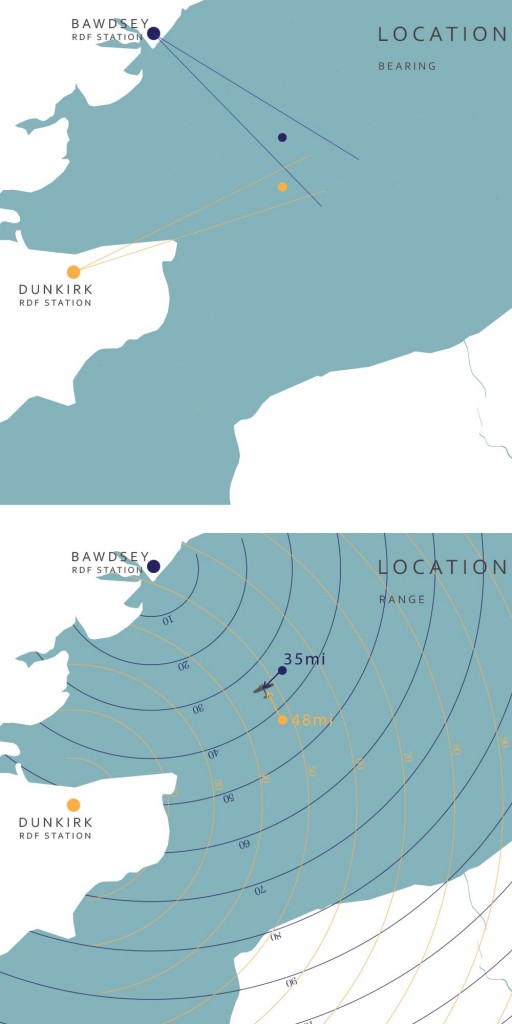 The first decision Filterers like Eileen had to make was where the aircraft were located.
The first decision Filterers like Eileen had to make was where the aircraft were located.
Here’s a simplified example with only 2 RDF stations: Bawdsey and Dunkirk. In reality, as many as 6 stations may be reporting the same raid. The colored dots in the image are “plots”. Those tell where the RDF stations see the incoming aircraft. You can see two plots, one for each RDF station. But here is the problem…there aren’t two separate planes. Those 2 dots are the same plane. This was because RDF was experimental, there was a lot of error. If the pilots tried to intercept the incoming aircraft based on data from one RDF station, they’d likely never see it.
This is why Dowding built his RDF stations in a chain, with each station supporting its neighbors. To provide redundant data sources. Even though the individual RDF stations were prone to error, multiple stations could be compared in the Filter Room to weed out the incorrect data. Two wrongs making a right.
The stations determine location using 2 measurements: direction from the station (bearing), and distance (range). Bearing was inaccurate. There was a standard error. Those location plots could be 15-20% off on the bearing. Range was much more accurate. So the Filterers like Eileen used it to determine the true location of the aircraft, through a process called Range Cutting. She uses the range arcs that are drawn on the Filter Room map, moving each plot along them. This keeps the range constant. She moves them together until they intersect. That’s the aircraft’s true location. With multiple data sources she’s filtered out the inaccuracy.
She knows where the aircraft are, but that’s only one decision, and the clock is still ticking. There are three more decisions to go.
2nd Decision – Number of Aircraft
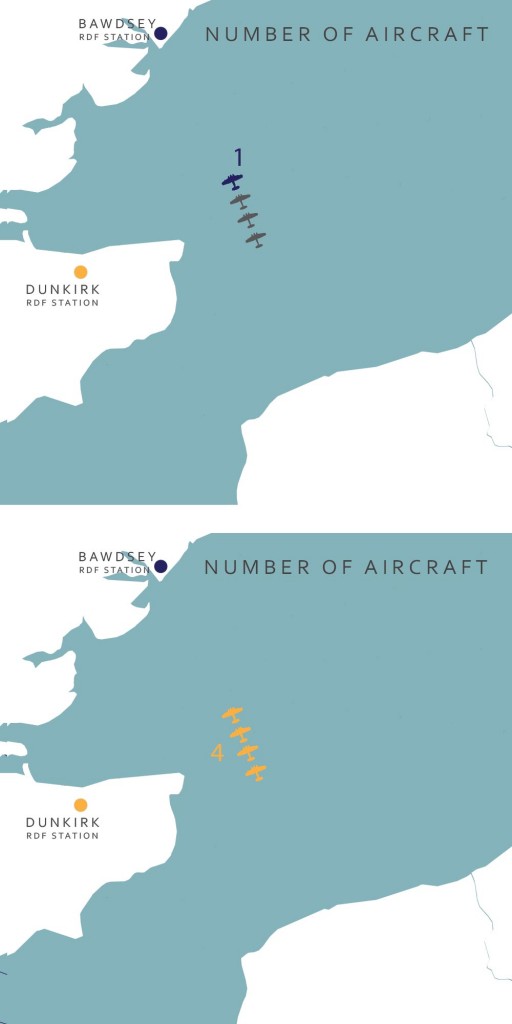 The squadrons also need to know how many aircraft are coming, so that enough fighters can be scrambled to attack them. If Eileen got this wrong the consequences could be deadly. Too few fighters launched and they could be overwhelmed. Too many and the RAF would waste its precious resources. They were already stretched thin. The problem here was that each station would see a different number of aircraft due to its position relative to the incoming aircraft .
The squadrons also need to know how many aircraft are coming, so that enough fighters can be scrambled to attack them. If Eileen got this wrong the consequences could be deadly. Too few fighters launched and they could be overwhelmed. Too many and the RAF would waste its precious resources. They were already stretched thin. The problem here was that each station would see a different number of aircraft due to its position relative to the incoming aircraft .
For example, if we have a flight of four German bombers, flying in a single line, Bawdsey station reports only one aircraft. The other aircraft are hidden by the leader.
But the station at Dunkirk is positioned to the side of the raiders. This means that it is in a better position to see all the aircraft. They would report 4 aircraft. This is a very simplified example, but it is indicative of the challenges faced by the Filterers like Eileen. They have to review the information from the different stations and quickly determine which station is in a position to report the number of aircraft most accurately.
A second crucial decision completed, but the clock is still ticking.
3rd Decision – Altitude
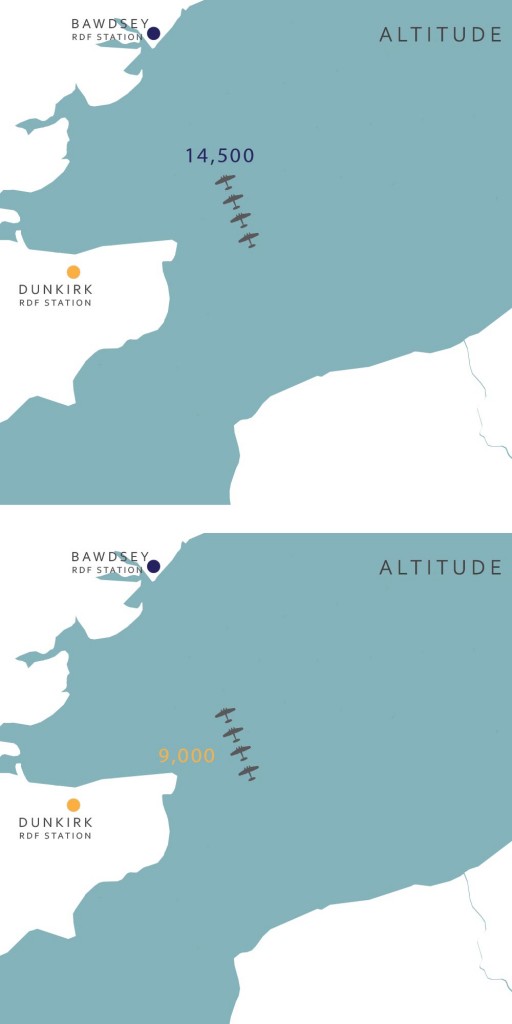 The squadron pilots also need to know the altitude of the incoming aircraft. In aerial combat height is advantage. But RDF did not have an easy way to determine altitude. The operator in the receiving station had to perform complex trigonometry calculations by hand, factoring for distance and the curvature of the earth. Obviously these readings were subject to how skilled and experienced the operator was. Were they good at math? Eileen had know. She had to have intimate knowledge of not only the stations, but the people on duty there.
The squadron pilots also need to know the altitude of the incoming aircraft. In aerial combat height is advantage. But RDF did not have an easy way to determine altitude. The operator in the receiving station had to perform complex trigonometry calculations by hand, factoring for distance and the curvature of the earth. Obviously these readings were subject to how skilled and experienced the operator was. Were they good at math? Eileen had know. She had to have intimate knowledge of not only the stations, but the people on duty there.
So let’s say in this example the operator at Bawdsey does the math and reports 14,500 feet, but Dunkirk’s operator has calculated it at 9,000 feet. That’s a huge discrepancy, and Eileen needs to resolve it. The obvious answer is to average them. Send the fighters to 11,750 feet. But that’s wrong. If the Germans are higher, the fighters may be “bounced” and destroyed.
In this example, she knows that the operator at Bawdsey is brand new to the job and that in the past Dunkirk has always been spot on with the calculations. Dunkirk wins. 9,000 feet. One decision to go.
4th Decision – Heading
The last thing that Eileen needs to determine is where the raiders are headed. While she is making all the other decisions, the Plotters continue plotting information from the RDF stations. When they plot a second location, the Eileen has enough information to determine where they are headed. She quickly corrects the second plot and places an arrow on the map. It points in the direction it is moving.
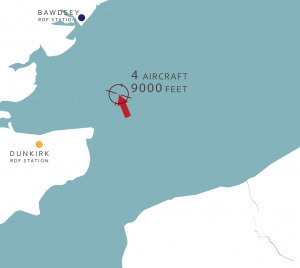 Once the arrow is placed on the table, the raid is real. No one questions or confirms the decision. It is communicated throughout the Dowding System. Tellers, standing on the balcony of the Filter Room, report it throughout the system.
Once the arrow is placed on the table, the raid is real. No one questions or confirms the decision. It is communicated throughout the Dowding System. Tellers, standing on the balcony of the Filter Room, report it throughout the system.
In less than two minutes, Filterers like Eileen made these four critical decisions. Decisions that drove the entire air defense system. Under immense pressure her judgment determined the fate of the squadron pilots and people on the ground. The system required that they make these decisions alone. There was simply no time to review, question, or approve her work. No superiors vetted her conclusions. She was young, inexperienced, and low in the organizational structure, yet she was entrusted to make decisions that affected the fate of the British Empire, and ultimately the free world. Everyone trusted her to do it, and she and countless others rose to the challenge.
Action This Day
This is a simple example of effective autonomy. People involved in all levels of the Dowding System were granted the autonomy to do their jobs. Dowding insisted that decisions should be made at the lowest possible level. He realized that for his air defense system to work, there was no time to do otherwise.
But as leaders and managers today, we probably do not face the same constraints. Most of us have more than two minutes to make crucial decisions. But does that mean that we shouldn’t give our employees the same autonomy in their jobs? This question is a hot topic in leadership right now. Dan Pink’s “Motivation 2.0” argues what Hugh Dowding already knew; that if you want the best from your employees, you should empower them to do their jobs. To make critical decisions. To take risks. To fail.
But it’s not enough just to say autonomy is good. Is all autonomy good for employee engagement? Is complete autonomy good for the organization? What does effective autonomy look like? How do you give your employees meaningful autonomy in a rigid, controlled environment?
Let’s start by looking at Eileen in the Filter Room. She obviously did not have complete autonomy. She was part of rigid military hierarchy. She worked in scheduled shifts. She faced stiff penalties for tardiness. She put on a uniform, wore her hair in the prescribed manner, and saluted her superiors. This is the opposite of autonomy. But despite her controlled work environment, she was given a free hand to make crucial decisions.
But even those decisions were part of a well-defined process. She knew what to expect, what decisions had to be made, and how fast she had to make them. There was even a well defined process to make those decisions. Today, this may reek of micromanagement. But it is not. The constraints imposed on Eileen’s work, coupled with her authority to make decisions, both defined her job and allowed her to master it. Micromanagement removes the authority to make decisions. Someone is always checking your work and requiring approval. That is the critical difference that defines the real problem.
We think autonomy is an “all or nothing” proposition. That to engage our employees we have to let them have a free hand to define their jobs, their responsibilities, and their goals. But this is wrong. At the extremes, these types of environments hurt engagement, descending into chaos. So instead we decide to give our employees tokens of autonomy: flexible schedules, telework, relaxed dress codes, etc. Read a few blogs on the subject; those are the typical solutions for autonomy in the workplace. These are the snake oil for increasing engagement. But I’ll argue that they are ineffective, because they are short-term fixes to the larger problem. Don’t believe me? Ask your employees which they would prefer: a game room at the office or the authority to own meaningful decisions in their work.
Let’s start a discussion about this. In the comments tell me about how you are struggling with autonomy and your workforce.
- What does autonomy look like in your teams?
- What challenges are you facing?
- Tell me about a time that an experiment with autonomy failed.
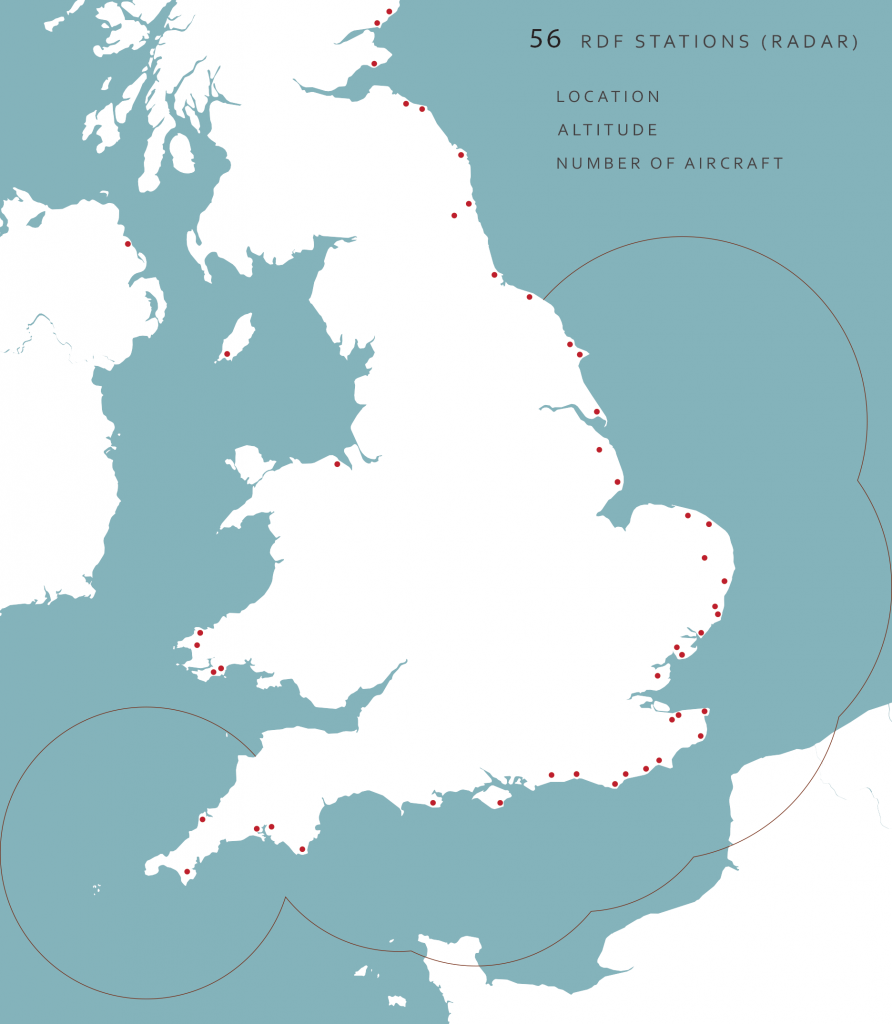
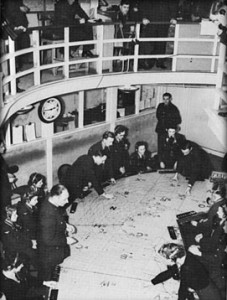
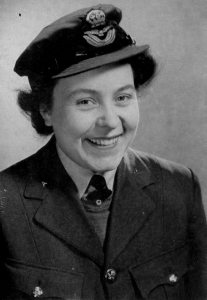
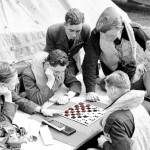
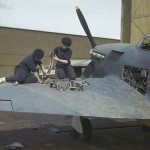
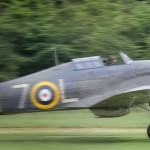
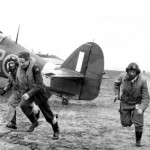

Pingback: viagra canadian()
Pingback: cialis online canada()
Pingback: viagra cialis()
Pingback: cialis 20 mg()
Pingback: Viagra medication()
Pingback: Real viagra online()
Pingback: generic cialis in usa()
Pingback: buy ciprofloxacin()
Pingback: viagra cialis()
Pingback: canadian pharmacy cialis()
Pingback: cost of cialis()
Pingback: buy generic cialis online()
Pingback: natural viagra()
Pingback: cialis 20 mg()
Pingback: street value of viagra 100mg()
Pingback: tylenol generic drug()
Pingback: viagra 100mg()
Pingback: chloroquine drug()
Pingback: cheap viagra()
Pingback: cheap viagra()
Pingback: viagra 100mg()
Pingback: erectile dysfunction drugs()
Pingback: buy erection pills()
Pingback: erectile dysfunction drug()
Pingback: walmart pharmacy()
Pingback: canadian pharmacy online()
Pingback: generic cialis()
Pingback: Buy cialis online()
Pingback: vardenafil pills()
Pingback: online levitra()
Pingback: levitra 10mg()
Pingback: sugarhouse casino online()
Pingback: real casinos online no deposit()
Pingback: sildenafil generic()
Pingback: casino games()
Pingback: casino slots()
Pingback: buy cialis generic()
Pingback: payday advance()
Pingback: online loans()
Pingback: cash payday()
Pingback: viagra prescription()
Pingback: casino moons online casino()
Pingback: cialis 5 mg()
Pingback: online casino keno games()
Pingback: online casino real money paypal()
Pingback: online casino games real money usa()
Pingback: cialis buy()
Pingback: casino online slots()
Pingback: cialis to buy()
Pingback: buy cialis()
Pingback: cialis buy()
Pingback: cheapest viagra 50 mg()
Pingback: buy chloroquine phosphate()
Pingback: viagra online canada()
Pingback: casino gambling()
Pingback: casino online slots()
Pingback: chumba casino()
Pingback: canadian pharmacy viagra()
Pingback: viagra prescription()
Pingback: viagra prices()
Pingback: viagra canada()
Pingback: canadian viagra()
Pingback: viagra pills for sale()
Pingback: generic cialis tadalafil()
Pingback: viagra without doctor prescription()
Pingback: buy cialis online cheap()
Pingback: best online pharmacy for viagra()
Pingback: legitimate generic viagra sites()
Pingback: cialis dosage()
Pingback: online viagra()
Pingback: purchase viagra()
Pingback: tadalafil liquid()
Pingback: online casinos real money()
Pingback: golden nugget online casino()
Pingback: viagra()
Pingback: http://cialistodo.com/()
Pingback: is buy generic viagra online()
Pingback: buy viagra online()
Pingback: droga5.net()
Pingback: cialis tablets()
Pingback: Viagra 100 mg purchase()
Pingback: Viagra 130 mg over the counter()
Pingback: buy viagra online()
Pingback: Viagra 130mg uk()
Pingback: cost of Viagra 150mg()
Pingback: Viagra 100mg online()
Pingback: Viagra 25 mg pharmacy()
Pingback: cialis online pharmacy()
Pingback: how to buy Viagra 200mg()
Pingback: Cialis 60 mg coupon()
Pingback: buy generic viagra()
Pingback: Cialis 20 mg without a prescription()
Pingback: Cialis 40 mg cheap()
Pingback: Cialis 10mg medication()
Pingback: viagra without a doctor prescription()
Pingback: order cialis()
Pingback: Cialis 40mg online pharmacy()
Pingback: online viagra()
Pingback: viagra pills()
Pingback: Cialis 40 mg tablets()
Pingback: buy sildenafil()
Pingback: sildenafil 100mg united kingdom()
Pingback: viagra generic()
Pingback: buy generic drugs without prescription()
Pingback: buy propecia 5 mg()
Pingback: lexapro 10mg generic()
Pingback: cheap generic viagra()
Pingback: best canadian online pharmacy reviews()
Pingback: cheapest generic viagra()
Pingback: aldactone 100 mg coupon()
Pingback: viagra sans ordonnance en pharmacie()
Pingback: allegra 120 mg otc()
Pingback: allopurinol 300mg nz()
Pingback: order amoxicillin 500mg()
Pingback: how to purchase ampicillin 500mg()
Pingback: antivert 25 mg pharmacy()
Pingback: arava 20 mg without a doctor prescription()
Pingback: cialis pills()
Pingback: strattera 25 mg nz()
Pingback: buy viagra in sweden 250()
Pingback: cheap tamoxifen 10mg()
Pingback: ashwagandha 60caps canada()
Pingback: ebay cialis()
Pingback: atarax 25 mg tablet()
Pingback: where to buy augmentin 250/125mg()
Pingback: avapro 150mg without a doctor prescription()
Pingback: avodart 0,5 mg usa()
Pingback: viagra 270 pills()
Pingback: baclofen 10 mg usa()
Pingback: bactrim 800/160mg without a doctor prescription()
Pingback: benicar 10 mg no prescription()
Pingback: how much does cialis cost()
Pingback: Biaxin 500mg united states()
Pingback: how to buy Premarin 0,625mg()
Pingback: female viagra()
Pingback: cialis import()
Pingback: viagra()
Pingback: cheapest calcium carbonate 500mg()
Pingback: buy cardizem 180 mg()
Pingback: generic viagra price()
Pingback: sildenafil citrate 100mg generic()
Pingback: casodex 50 mg pharmacy()
Pingback: order cialis generic()
Pingback: catapres 100mcg generic()
Pingback: ceclor 250mg without a doctor prescription()
Pingback: ceftin cheap()
Pingback: celexa without a doctor prescription()
Pingback: cephalexin 500 mg coupon()
Pingback: medications for ed()
Pingback: cipro 750mg online pharmacy()
Pingback: order claritin 10mg()
Pingback: best online casino for money()
Pingback: canadian pharmacy viagra()
Pingback: tadalafil tablets()
Pingback: legitimate online slots for money()
Pingback: best online casino for money()
Pingback: casino slots()
Pingback: online casinos for usa players()
Pingback: real money online casino()
Pingback: what is the difference between viagra cialis and levitra()
Pingback: free slots online()
Pingback: online casino usa real money()
Pingback: jackpot party casino()
Pingback: generic cialis()
Pingback: casinos()
Pingback: get a car insurance quotes()
Pingback: car insurance quotes texas online()
Pingback: auto and home insurance quotes()
Pingback: buy viagra without a prescription()
Pingback: progressive car insurance quotes()
Pingback: inexpensive car insurance quotes()
Pingback: cialis()
Pingback: car insurance online()
Pingback: insurance auto()
Pingback: abc car insurance()
Pingback: cheapest car insurance quotes()
Pingback: safecar insurance()
Pingback: instant personal loans()
Pingback: Buy viagra com()
Pingback: quick payday loans()
Pingback: legitimate viagra online()
Pingback: payday loans colorado()
Pingback: installment loans companies()
Pingback: payday quick loans()
Pingback: bad credit loans bad credit()
Pingback: viagra discounts()
Pingback: payday loans online no credit check()
Pingback: personal loans()
Pingback: cbd oil reviews complaints()
Pingback: buy amoxicillin online no prescription()
Pingback: benefits of cbd rich hemp oil()
Pingback: generic viagra from india online()
Pingback: medterra cbd oil website()
Pingback: cbd oil for pain control()
Pingback: sildenafil 100 online()
Pingback: buy viagra in the uk()
Pingback: medterra cbd oil website()
Pingback: buy generic viagra online uk()
Pingback: hemp cbd oil side effects()
Pingback: viagra mastercard()
Pingback: cbd oil for pain relief from ra()
Pingback: cbd oil for cancer patients chocolate()
Pingback: payday loans()
Pingback: purchase sildenafil citrate()
Pingback: photo assignment()
Pingback: female pink viagra()
Pingback: term paper writer()
Pingback: essaywritingservices()
Pingback: should homework be abolished()
Pingback: how to writing essay()
Pingback: buy viagra discover card()
Pingback: demand assigned multiple access()
Pingback: american essay writing service()
Pingback: buy college essays()
Pingback: cheap custom essay writing service()
Pingback: write my paper()
Pingback: where to viagra online()
Pingback: cleocin 150 mg purchase()
Pingback: clomid pills()
Pingback: clonidine without prescription()
Pingback: clozaril for sale()
Pingback: colchicine without a prescription()
Pingback: how to buy symbicort inhaler 160/4,5mcg()
Pingback: mexico cialis()
Pingback: combivent 50/20 mcg purchase()
Pingback: essay writing helper()
Pingback: coreg 12,5mg price()
Pingback: cheap compazine 5mg()
Pingback: coumadin medication()
Pingback: Get viagra fast()
Pingback: essay help online()
Pingback: where to buy cozaar()
Pingback: generic viagra deals()
Pingback: crestor 10 mg united states()
Pingback: dissertations express()
Pingback: cheap cymbalta()
Pingback: college research paper writing service()
Pingback: buy viagra()
Pingback: dapsone 1000caps online()
Pingback: ddavp united states()
Pingback: where can i buy depakote()
Pingback: diamox 250 mg generic()
Pingback: differin 15g without a doctor prescription()
Pingback: diltiazem without a doctor prescription()
Pingback: Generic viagra in canada()
Pingback: doxycycline 100mg cheap()
Pingback: cheap dramamine 50 mg()
Pingback: canada pharmacy online()
Pingback: elavil 25mg for sale()
Pingback: buy erythromycin 500 mg()
Pingback: Amoxil()
Pingback: where can i buy etodolac 300 mg()
Pingback: flomax 0,4 mg nz()
Pingback: flonase nasal spray 50 mcg uk()
Pingback: erectile dysfunction()
Pingback: geodon 80 mg over the counter()
Pingback: hyzaar 12,5 mg australia()
Pingback: imdur without a doctor prescription()
Pingback: cialis dose()
Pingback: generic cialis cost()
Pingback: imitrex online pharmacy()
Pingback: buy viagra()
Pingback: imodium 2mg united kingdom()
Pingback: buy generic viagra online()
Pingback: her latest blog()
Pingback: viagra ingredients()
Pingback: does viagra work()
Pingback: how long does viagra take to work()
Pingback: approved canadian pharmacies online()
Pingback: viagra canada()
Pingback: imuran 25 mg coupon()
Pingback: zithromax for sale online()
Pingback: indocin usa()
Pingback: lamisil over the counter()
Pingback: levaquin prices()
Pingback: viagra for sale()
Pingback: lopid uk()
Pingback: lopressor tablets()
Pingback: viagra without doctor prescription()
Pingback: luvox price()
Pingback: macrobid 100mg without a prescription()
Pingback: meclizine 25mg uk()
Pingback: viagra order()
Pingback: ed meds online without doctor prescription()
Pingback: mestinon 60 mg online pharmacy()
Pingback: buy micardis 20mg()
Pingback: rx price comparison()
Pingback: cheap Plaquenil()
Pingback: mobic united kingdom()
Pingback: best canadian online pharmacy()
Pingback: Keflex()
Pingback: cheap drugs()
Pingback: motrin without prescription()
Pingback: cheapest nortriptyline 25mg()
Pingback: approved canadian online pharmacies()
Pingback: viagra availability in delhi()
Pingback: periactin prices()
Pingback: canadian online pharmacies()
Pingback: cost of phenergan()
Pingback: how to buy plaquenil()
Pingback: prednisolone without a doctor prescription()
Pingback: prevacid 15mg coupon()
Pingback: prilosec uk()
Pingback: proair inhaler without prescription()
Pingback: generic viagra()
Pingback: order procardia 30mg()
Pingback: how much viagra should i take the first time?()
Pingback: proscar prices()
Pingback: protonix price()
Pingback: where can i buy provigil()
Pingback: how to get viagra samples()
Pingback: pulmicort 200 mcg without prescription()
Pingback: zithromax 250 price()
Pingback: pyridium cost()
Pingback: medicine amoxicillin 500()
Pingback: where to buy reglan()
Pingback: benadryl order online()
Pingback: remeron 15 mg nz()
Pingback: retin-a cream without a prescription()
Pingback: revatio united kingdom()
Pingback: risperdal 1 mg australia()
Pingback: robaxin 500 mg australia()
Pingback: how to buy rogaine 5%()
Pingback: seroquel pills()
Pingback: singulair 4 mg australia()
Pingback: skelaxin 400 mg australia()
Pingback: canadian viagra()
Pingback: spiriva online pharmacy()
Pingback: tenormin 100mg otc()
Pingback: viagra online canada()
Pingback: where can i buy thorazine()
Pingback: toprol 100 mg cost()
Pingback: tricor without a doctor prescription()
Pingback: valtrex 500 mg uk()
Pingback: verapamil 40mg australia()
Pingback: voltaren 50 mg pills()
Pingback: wellbutrin canada()
Pingback: where to buy zanaflex()
Pingback: difference between cialis and cialis professional()
Pingback: zithromax 500mg cheap()
Pingback: click reference()
Pingback: zocor 40mg medication()
Pingback: zithromax prescription()
Pingback: zovirax 800 mg cheap()
Pingback: zyloprim united states()
Pingback: zyprexa 7,5mg united kingdom()
Pingback: generic viagra super active 100mg()
Pingback: how to buy zyvox()
Pingback: sildenafil prices()
Pingback: tadalafil united kingdom()
Pingback: furosemide no prescription()
Pingback: escitalopram online()
Pingback: amoxicillin 500 mg tablet()
Pingback: aripiprazole without prescription()
Pingback: pioglitazone 30 mg pharmacy()
Pingback: spironolactone pills()
Pingback: best canadian online pharmacy()
Pingback: fexofenadine cost()
Pingback: cheapest glimepiride 4mg()
Pingback: leflunomide 10 mg uk()
Pingback: buy atomoxetine()
Pingback: order donepezil()
Pingback: cost of anastrozole 1mg()
Pingback: viagra()
Pingback: irbesartan generic()
Pingback: dutasteride 0,5mg canada()
Pingback: olmesartan 20mg prices()
Pingback: buspirone without a prescription()
Pingback: clonidine 0.1mg united kingdom()
Pingback: cefuroxime 125mg tablet()
Pingback: canada toronto cheap fase cialis()
Pingback: where to buy citalopram 10 mg()
Pingback: cephalexin 500 mg canada()
Pingback: cheap cialis()
Pingback: cheap ciprofloxacin()
Pingback: loratadine 10mg costloratadine without a doctor prescription()
Pingback: cialis coupon()
Pingback: clindamycin 150mg otc()
Pingback: cialis viagra levitra young yahoo()
Pingback: clozapine 25mg tablets()
Pingback: generic vs brand name viagra()
Pingback: prochlorperazine 5mg tablets()
Pingback: medications without a doctor's prescription()
Pingback: carvedilol 25mg prices()
Pingback: where can i buy warfarin 2 mg()
Pingback: how to obtain cialis()
Pingback: rosuvastatin 10 mg united kingdom()
Pingback: cost of desmopressin 0.1mg()
Pingback: order divalproex()
Pingback: how to purchase trazodone 100mg()
Pingback: cheap tolterodine 1 mg()
Pingback: sildenafil 20mg online prescription()
Pingback: acetazolamide 250 mg online pharmacy()
Pingback: fluconazole for sale()
Pingback: viagra uk over the counter()
Pingback: phenytoin 100 mg online()
Pingback: oxybutynin 2.5mg otc()
Pingback: order doxycycline 100 mg()
Pingback: viagra no prescription cialis()
Pingback: bisacodyl uk()
Pingback: buy viagra from canada are they real()
Pingback: how to purchase venlafaxine()
Pingback: buy cheap viagra()
Pingback: amitriptyline otc()
Pingback: permethrin united kingdom()
Pingback: where to buy cialis online without a presription()
Pingback: erythromycin 250mg united states()
Pingback: wqrbivaq()
Pingback: generic cialis()
Pingback: estradiol 2 mg tablets()
Pingback: etodolac 300mg pharmacy()
Pingback: ed drugs()
Pingback: pxpicmhm()
Pingback: best ed drug()
Pingback: fluticasone 50mcg prices()
Pingback: what cialis do()
Pingback: alendronate 70mg tablet()
Pingback: how long does a viagra pill last()
Pingback: wat kost cialis 20 mg bij de apotheek()
Pingback: hoe lang duurt het voor viagra werkt()
Pingback: where to buy ivermectin without a rx()
Pingback: nitrofurantoin 100mg over the counter()
Pingback: best over the counter viagra()
Pingback: how long does it take zithromax to take effect()
Pingback: glipizide price()
Pingback: lasix furosemide 40 mg()
Pingback: where can i buy viagra in the uk()
Pingback: hydrochlorothiazide without prescription()
Pingback: buy flagyl online()
Pingback: isosorbide 60 mg pills()
Pingback: buy bactrim online()
Pingback: sumatriptan medication()
Pingback: cialis generico comprar()
Pingback: loperamide 2mg without a doctor prescription()
Pingback: cialis()
Pingback: generic viagra prices()
Pingback: cheapest viagra cialis levitra()
Pingback: order minocin online()
Pingback: azathioprine 25mg tablet()
Pingback: how long does 20mg cialis keep in system()
Pingback: propranolol cheap()
Pingback: viagra()
Pingback: viagra brand 100mg()
Pingback: how long does it take cialis to take effect()
Pingback: how to write a community service essay()
Pingback: cheap write my research paper()
Pingback: write my essay for free()
Pingback: help me write this essay()
Pingback: indomethacin 75mg for sale()
Pingback: how to purchase lamotrigine()
Pingback: terbinafine pharmacy()
Pingback: levofloxacin 250mg medication()
Pingback: medications without a doctor's prescription()
Pingback: amoxicillin no script()
Pingback: furosemide 80()
Pingback: azithromycin price in india()
Pingback: buy real viagra online()
Pingback: ivermectin 3mg dose()
Pingback: ventolin 4mg uk()
Pingback: best place to buy generic viagra online()
Pingback: viagra cost()
Pingback: gemfibrozil australia()
Pingback: zithromax drug()
Pingback: order metoprolol 50 mg()
Pingback: best over the counter viagra()
Pingback: doxycycline pill()
Pingback: prednisolone nursing implications()
Pingback: clomid or nolvadex()
Pingback: priligy vs dapoxetine()
Pingback: diflucan symptom relief()
Pingback: synthroid 125()
Pingback: where can i buy metoclopramide 10 mg()
Pingback: ed pills online()
Pingback: best essay editing service()
Pingback: zithromax for sale us()
Pingback: neurontin online usa()
Pingback: write my essays()
Pingback: zithromax 500 mg lowest price drugstore online()
Pingback: propecia gyno()
Pingback: buy academic papers()
Pingback: all generic meds from india()
Pingback: cymbalta and neurontin()
Pingback: metformin and phentermine()
Pingback: paxil drowsiness()
Pingback: plaquenil rash pictures()
Pingback: generic pills india()
Pingback: cialis pills()
Pingback: pharmacy online shopping()
Pingback: non prescription viagra()
Pingback: clomid online purchase()
Pingback: amoxicillin online no prescription()
Pingback: metformin 500 mg without prescription()
Pingback: buy generic propecia()
Pingback: propecia pill()
Pingback: Neurontin()
Pingback: best male enhancement pills()
Pingback: lasix loop diuretic()
Pingback: buying prescription drugs from canada()
Pingback: canada pharmaceuticals online generic()
Pingback: Cialis Professional()
Pingback: best online pharmacy for viagra()
Pingback: cialis online without prescription()
Pingback: generic cialis usa()
Pingback: viagra()
Pingback: How To Cancel Tinder Gold Subscription Android()
Pingback: buy lisinopril online india()
Pingback: zestoretic 25()
Pingback: free lesbian platonic dating sites()
Pingback: compare viagra cialis levitra()
Pingback: cialis marke 20mg()
Pingback: buy cialis doctor()
Pingback: medical mall pharmacy()
Pingback: 10mg cialis price()
Pingback: cheapest generic cialis australia()
Pingback: can you take cialis with high blood pressure()
Pingback: cialis® online()
Pingback: how to buy cialis online from canada()
Pingback: buy cialis online viagra()
Pingback: online pharmacy tech jobs()
Pingback: cialis without prescriptions canada()
Pingback: cialis without presciption in usa()
Pingback: canadian pharmacy antibiotics()
Pingback: cialis 20mg low price()
Pingback: non prescription erection pills()
Pingback: valtrex daily use()
Pingback: best treatment for ed()
Pingback: foods for ed()
Pingback: п»їviagra pills()
Pingback: buy doxycycline hyclate 100mg without a rx()
Pingback: cheap erectile dysfunction pill()
Pingback: natural ed cures()
Pingback: stromectol tablets()
Pingback: buy stromectol uk()
Pingback: hydroxychloroquine where to buy()
Pingback: how much is plaquenil()
Pingback: lowest price for priligy()
Pingback: ivermectin cream cost()
Pingback: salbutamol inhaler cost()
Pingback: ivermectin for sale()
Pingback: recommended dose for hydroxychloroquine()
Pingback: ivermectin where to buy()
Pingback: cvs prescription prices without insurance()
Pingback: best ed treatments()
Pingback: where can i get hydroxychloroquine online()
Pingback: how much is viagra()
Pingback: viagra online usa()
Pingback: cheapest generic cialis australia()
Pingback: generic cialis 20 mg tadalafil()
Pingback: what companies manufacture hydroxychloroquine()
Pingback: cialis20mg()
Pingback: paypal cialis no prescription()
Pingback: hydroxychloroquine retinopathy symptoms()
Pingback: viagra sale()
Pingback: cialis vs viagra germany()
Pingback: max dosage of cialis()
Pingback: where to get zithromax()
Pingback: zithromax 500 tablet()
Pingback: MKsOrb.Com()
Pingback: azithromycin zithromax()
Pingback: pharmacy technician online schools()
Pingback: how much is generic viagra()
Pingback: ivermectil 6 mg()
Pingback: https://regcialist.com/()
Pingback: ivermectin 2%()
Pingback: erection pills()
Pingback: male dysfunction treatment()
Pingback: plaquenil medication()
Pingback: plaquenil 400 mg()
Pingback: ivermectin pediatric dose()
Pingback: medicine priligy tablets()
Pingback: purchase cialis with paypal()
Pingback: cialis priligy online australia()
Pingback: prednisone 20 mg without prescription()
Pingback: maximum dose of hydrochlorothiazide()
Pingback: maximum dose of norvasc()
Pingback: generic name for lipitor()
Pingback: best time to take prilosec()
Pingback: doxycycline stromectol()
Pingback: quetiapine depression dose()
Pingback: zoloft reviews for anxiety()
Pingback: recommended canadian online pharmacies()
Pingback: legitimate canadian pharmaceuticals online()
Pingback: duloxetine for neuropathic pain()
Pingback: buy viagra online cheap()
Pingback: viagra online canada()
Pingback: online pharmacy viagra()
Pingback: can you buy prednisone over counter()
Pingback: sildenafil generic()
Pingback: buy cialis cheap()
Pingback: buy cialis pills()
Pingback: stromectol for infants()
Pingback: cialis for women()
Pingback: t plaquenil()
Pingback: lexapro dosages()
Pingback: ivermectin uk()
Pingback: viagra cheap()
Pingback: viagra sample()
Pingback: bupropion duloxetine interaction()
Pingback: online viagra prescription()
Pingback: cialis samples()
Pingback: 1()
Pingback: sildenafil citrate 100mg()
Pingback: buy cheap sildenafil online()
Pingback: sildenafil 50 mg buy online()
Pingback: can you get high off amoxil()
Pingback: cialis logo()
Pingback: generic viagra()
Pingback: generic viagra 100mg()
Pingback: cialis pharmacy()
Pingback: propecia online pharmacy sellers()
Pingback: can you buy prednisone over the counter in usa()
Pingback: sildenafil 20mg()
Pingback: cialis without a script()
Pingback: viagra 100 price in india()
Pingback: stromectol ivermectin dose()
Pingback: sildenafil 20 mg coupon()
Pingback: ivermectin kill fleas()
Pingback: tadalafil tablets 10 mg price()
Pingback: sildenafil prescription nz()
Pingback: where can i buy cialis pills()
Pingback: zpak treatment()
Pingback: ivermectin poisoning()
Pingback: buy ivermectin for humans usa()
Pingback: albuterol cost cvs()
Pingback: best buy generic viagra()
Pingback: viagra connect vs cambia()
Pingback: ivermectin and covid-19()
Pingback: buy generic viagra india online()
Pingback: ivermectin for covid mayo clinic()
Pingback: street price of viagra 100mg()
Pingback: discount tadalafil()
Pingback: teva generic cialis price()
Pingback: expired zithromax()
Pingback: buy pfizer viagra india()
Pingback: generic viagra online pharmacy uk()
Pingback: cialis generic price()
Pingback: pharmacy usa online()
Pingback: sildenafil 20 mg()
Pingback: ivermectin for ticks()
Pingback: is it safe to take metoprolol with lisinopril()
Pingback: payday loans kansas city mo()
Pingback: dreams casino reviews()
Pingback: cheap viagra online canadian pharmacy()
Pingback: stromectol msd()
Pingback: levitra avec dapoxetine()
Pingback: clomiphene generic price()
Pingback: ivermectin anti parasitic()
Pingback: will ivermectin kill corona()
Pingback: azithromycin over the counter usa()
Pingback: viagra coupon()
Pingback: clamelle otc()
Pingback: viagra men()
Pingback: best price for real viagra()
Pingback: sildenafil 100mg tablets uk()
Pingback: non subscription ed()
Pingback: viagra government funded()
Pingback: sildenafilo()
Pingback: how to get prescriptions without a doctor()
Pingback: viagra side effects()
Pingback: buy amoxicillin 500()
Pingback: women viagra()
Pingback: 100 mg furosemide()
Pingback: generic neurontin()
Pingback: plaquenil eye()
Pingback: prednisone pack()
Pingback: bestellen viagra()
Pingback: dapoxetine 10 mg()
Pingback: generic for provigil()
Pingback: chloroquine and hydroxychloroquine for sale()
Pingback: ivermectin 50mgml()
Pingback: albuterol price 5mg()
Pingback: otc viagra 2022()
Pingback: azithromycin cost()
Pingback: generic lasix()
Pingback: viagra jokes()
Pingback: plaquenil tabs()
Pingback: natural viagra for men()
Pingback: prednisone us()
Pingback: stromectol for sale in mexico()
Pingback: albuterol 63 mg()
Pingback: canada generic tadalafil()
Pingback: hims viagra()
Pingback: over the counter viagra substitute()
Pingback: viagra pills for men()
Pingback: buy viagra()
Pingback: bbw sex games()
Pingback: sildenafil 100mg coupon()
Pingback: cost of cialis for daily use()
Pingback: otc viagra()
Pingback: fildena()
Pingback: viagra alternatives()
Pingback: roman sildenafil()
Pingback: stromectol buy uk()
Pingback: generic cialis 20 mg pills look like()
Pingback: generic sildenafil 25mg()
Pingback: high limit slots jackpot()
Pingback: viagra costs()
Pingback: warnings for viagra()
Pingback: levitra dosage()
Pingback: what to do if sildenafil pills do not work for you()
Pingback: brand cialis singapore()
Pingback: viagra online()
Pingback: cialis 5mg tablets()
Pingback: eli lilly cialis()
Pingback: levitra vs cialis()
Pingback: viagra buy greece()
Pingback: purchasing cialis()
Pingback: sildenafil walmart()
Pingback: meds pharmacy()
Pingback: sildenafil 100mg tablets()
Pingback: where to buy azithromycin()
Pingback: cialis coupon printable()
Pingback: how to get cialis prescription()
Pingback: https://mobviagrweb.com()
Pingback: viagra tablet in saudi arabia price()
Pingback: viagra at walmart()
Pingback: meloxicam dosage for sheep()
Pingback: ivermectin coronavirus()
Pingback: ventolin generic()
Pingback: ivermectin 6()
Pingback: tadalafil indian brands()
Pingback: buy viagra fast shipping()
Pingback: discount generic viagra()
Pingback: side effects of ivermectin in humans()
Pingback: stromectol xr()
Pingback: order albuterol for nebulizer()
Pingback: do you need prescription for viagra()
Pingback: how to buy ivermectin()
Pingback: flcc()
Pingback: clomid united states()
Pingback: buy 100mg clomid uk()
Pingback: tizanidine 122()
Pingback: olumiant 4 mg price()
Pingback: pharmacies()
Pingback: flccc ivermectin prophylaxis()
Pingback: bimatoprost otc()
Pingback: ivermectin lice oral()
Pingback: ivermectin ireland()
Pingback: stromectol nz()
Pingback: ivermectin 1()
Pingback: stromectol generic()
Pingback: buy ivermectin canada()
Pingback: ivermectin price comparison()
Pingback: ivermectin 0.5 lotion india()
Pingback: stromectol 3mg()
Pingback: where can i get ivermectin()
Pingback: buy viagra generic canada()
Pingback: ivermectin uk()
Pingback: is ivermectin safe for humans()
Pingback: ivermectin tablets()
Pingback: ivermectin for sale()
Pingback: ivermectin for humans()
Pingback: ignition casino update()
Pingback: how long does ivermectin stay in your body()
Pingback: meritroyalbet()
Pingback: madridbet()
Pingback: meritking()
Pingback: meritking()
Pingback: cost of ivermectin()
Pingback: how can i get cheap cialis()
Pingback: prednisone 40mg oral()
Pingback: buy cipla sildalis()
Pingback: meritroyalbet()
Pingback: meritroyalbet()
Pingback: elexusbet()
Pingback: meritroyalbet()
Pingback: what is tadalafil()
Pingback: provigil online()
Pingback: ivermectin 3mg for lice()
Pingback: ivermectin()
Pingback: cialis everyday()
Pingback: tadalafil 100mg tablets()
Pingback: how to get viagra()
Pingback: cialis viagra without doctor prescription()
Pingback: zithromax 250 mg()
Pingback: ivermectin for humans over the counter()
Pingback: cost for generic cialis()
Pingback: prices for cialis in canada()
Pingback: baymavi()
Pingback: baymavi()
Pingback: how to buy viagra online from canada()
Pingback: buy real cialis cheap()
Pingback: sildenafil pills generic brand()
Pingback: warnings for tadalafil()
Pingback: cialis tabletas()
Pingback: ed drugs online from canada()
Pingback: cvs prescription prices without insurance()
Pingback: buy ivermectin for humans()
Pingback: purchase sildenafil pills()
Pingback: levitra 10 mg rezeptfrei()
Pingback: how to buy sildenafil pills()
Pingback: tombala siteleri()
Pingback: tadalafil and dapoxetine()
Pingback: calis()
Pingback: prednisone 20mg short term side effects()
Pingback: side effects prednisone 20mg tablets()
Pingback: can you buy cialis in canada()
Pingback: molnupiravir price()
Pingback: merck fda()
Pingback: 1vampire()
Pingback: cheapest online generic cialis()
Pingback: cialis generika kaufen rezeptfrei seriös()
Pingback: le cialis()
Pingback: meritroyalbet()
Pingback: eurocasino()
Pingback: ivermectin without a doctor prescription()
Pingback: prednisone side effects in men()
Pingback: natural viagra()
Pingback: cheap cialis india()
Pingback: stromectol 0.5 mg()
Pingback: zone free online casino games()
Pingback: how can i get cheap cialis()
Pingback: stromectol uk buy()
Pingback: stromectol online pharmacy()
Pingback: real money slots()
Pingback: clindamycin mechanism()
Pingback: cheap cialis india()
Pingback: cheap generic viagra canada()
Pingback: buy generic cialis online()
Pingback: erythromycin optho()
Pingback: buy ivermectin for humans uk()
Pingback: ciprofloxacin lawsuit()
Pingback: augmentin med()
Pingback: ivermectina tabletas()
Pingback: cialis 20mg united states()
Pingback: ivermectin 3mg for sale()
Pingback: ivermectin bestellen()
Pingback: cost of stromectol medication()
Pingback: ivermectin 12mg online()
Pingback: buy doxycycline online()
Pingback: zithromax antibiotics()
Pingback: ivermectin eye drops()
Pingback: ivermectin manufacturers()
Pingback: augmentin classification()
Pingback: how to make natural viagra()
Pingback: generic tadalafil()
Pingback: azithromycin msds()
Pingback: augmentin ototoxicity()
Pingback: ivermectin 6()
Pingback: order azithromycin()
Pingback: ivermectin lotion for scabies()
Pingback: minocycline 50 mg pills online()
Pingback: order ivermectin online()
Pingback: celebrex 100 mg()
Pingback: buy ivermectin 12mg otc()
Pingback: ivermectin human use()
Pingback: meritroyalbet()
Pingback: furosemide 80 mg price()
Pingback: meritking()
Pingback: eurocasino()
Pingback: trcasino()
Pingback: can you buy furosemide over the counter in canada()
Pingback: ivermectin 20 mg()
Pingback: india to buy cialis()
Pingback: tadalafil generic usa()
Pingback: where to buy ivermectin pills()
Pingback: eurocasino()
Pingback: eurocasino()
Pingback: ivermectin 6mg()
Pingback: ivermectin price canada()
Pingback: ivermectin pills()
Pingback: ivermectin 3 mg()
Pingback: no prescription viagra price compare()
Pingback: ivermectin 4000 mcg()
Pingback: discount cialis()
Pingback: madridbet giriş()
Pingback: luckyland slots casino()
Pingback: cialis free 30 day trial()
Pingback: ivermectine sans ordonnance()
Pingback: how to get hydroxychloroquine online()
Pingback: where to buy ivermectin pills()
Pingback: use cialis promise coupon orlando fl()
Pingback: ivermectin 200()
Pingback: what is ivermectin for dogs()
Pingback: cialis otc()
Pingback: clomid in mexico()
Pingback: clomid tablets in india()
Pingback: clomidmedication.co.uk()
Pingback: stromectol preis()
Pingback: can i buy clomid over the counter singapore()
Pingback: ivermectin paste()
Pingback: child porn()
Pingback: how to get ivermectin australia()
Pingback: cialis otc()
Pingback: medications online()
Pingback: prescription drugs without doctor approval()
Pingback: male erectile dysfunction()
Pingback: ivermectin shampoo()
Pingback: ivermectin shampoo for guinea pigs()
Pingback: ivermectin paste 1.87 for horses()
Pingback: ivermectin rx()
Pingback: best treatment for ed()
Pingback: hydroxychloroquine()
Pingback: erectile dysfunction medication()
Pingback: meds online without doctor prescription()
Pingback: hydroxychloroquine pronunciation()
Pingback: buy prescription drugs without doctor()
Pingback: canadian pharmacy online()
Pingback: tadalafil()
Pingback: how to get cialis without a prescription()
Pingback: stromectol amazon()
Pingback: viagra price()
Pingback: cialis 20 mg sale()
Pingback: ivermectina 6mg for sale()
Pingback: psy-()
Pingback: otc ivermectin()
Pingback: projectio()
Pingback: moskva psiholog online()
Pingback: slovar po psihoanalizu laplansh()
Pingback: psy online()
Pingback: uels ukrain()
Pingback: bahis siteleri()
Pingback: ivermectin for sale()
Pingback: DPTPtNqS()
Pingback: qQ8KZZE6()
Pingback: D6tuzANh()
Pingback: SHKALA TONOV()
Pingback: Øêàëà òîíîâ()
Pingback: russianmanagement.com()
Pingback: chelovek-iz-90-h()
Pingback: 3Hk12Bl()
Pingback: 3NOZC44()
Pingback: 01211()
Pingback: tor-lyubov-i-grom()
Pingback: film-tor-2022()
Pingback: hd-tor-2022()
Pingback: ivermectin topical()
Pingback: Psikholog()
Pingback: netstate.ru()
Pingback: Link()
Pingback: ivermectin ld50 human()
Pingback: tor-lyubov-i-grom.ru()
Pingback: psy()
Pingback: chelovek soznaniye mozg()
Pingback: cheap stromectol without a doctor prescription()
Pingback: bit.ly()
Pingback: cleantalkorg2.ru()
Pingback: bucha killings()
Pingback: War in Ukraine()
Pingback: Ukraine()
Pingback: Ukraine news live()
Pingback: The Latest Ukraine News()
Pingback: viagra()
Pingback: stromectol where to buy()
Pingback: site()
Pingback: sildenafil citrate()
Pingback: stats()
Pingback: Ukraine-war()
Pingback: movies()
Pingback: gidonline()
Pingback: revatio()
Pingback: stromectol stromectol()
Pingback: mir dikogo zapada 4 sezon 4 seriya()
Pingback: web()
Pingback: film.8filmov.ru()
Pingback: video()
Pingback: cialis cheap()
Pingback: film()
Pingback: buy cialis over the counter at walmart()
Pingback: liusia-8-seriiaonlain()
Pingback: smotret-polnyj-film-smotret-v-khoroshem-kachestve()
Pingback: canada cialis()
Pingback: filmgoda.ru()
Pingback: rodnoe-kino-ru()
Pingback: stat.netstate.ru()
Pingback: sY5am()
Pingback: Dom drakona()
Pingback: JGXldbkj()
Pingback: aOuSjapt()
Pingback: ìûøëåíèå()
Pingback: psikholog moskva()
Pingback: A片()
Pingback: pornoizle}()
Pingback: porno}()
Pingback: Usik Dzhoshua 2 2022()
Pingback: Dim Drakona 2022()
Pingback: TwnE4zl6()
Pingback: psy 3CtwvjS()
Pingback: lalochesia()
Pingback: film onlinee()
Pingback: programma peredach na segodnya()
Pingback: psycholog-v-moskve.ru()
Pingback: psycholog-moskva.ru()
Pingback: 3qAIwwN()
Pingback: video-2()
Pingback: sezons.store()
Pingback: socionika-eniostyle.ru()
Pingback: psy-news.ru()
Pingback: 000-1()
Pingback: 3SoTS32()
Pingback: 3DGofO7()
Pingback: wwwi.odnoklassniki-film.ru()
Pingback: buy hydroxychloroquine 200 mg()
Pingback: rftrip.ru()
Pingback: hydroxychloroquine (plaquenil)()
Pingback: dolpsy.ru()
Pingback: kin0shki.ru()
Pingback: 3o9cpydyue4s8.ru()
Pingback: mb588.ru()
Pingback: history-of-ukraine.ru news ukraine()
Pingback: newsukraine.ru()
Pingback: sildenafil kamagra()
Pingback: edu-design.ru()
Pingback: tftl.ru()
Pingback: brutv()
Pingback: site 2023()
Pingback: where to buy propecia online uk()
Pingback: propecia mail order canada()
Pingback: sitestats01()
Pingback: 1c789.ru()
Pingback: cttdu.ru()
Pingback: 1703()
Pingback: hdserial2023.ru()
Pingback: serialhd2023.ru()
Pingback: matchonline2022.ru()
Pingback: kamagra 100mg()
Pingback: bit.ly/3OEzOZR()
Pingback: bit.ly/3gGFqGq()
Pingback: vidalista 80mg()
Pingback: bit.ly/3ARFdXA()
Pingback: bit.ly/3ig2UT5()
Pingback: bit.ly/3GQNK0J()
Pingback: grandpashabet()
Pingback: levitra generic vardenafil()
Pingback: grandpashabet()
Pingback: bep5w0Df()
Pingback: stromectol ca()
Pingback: www()
Pingback: icf()
Pingback: 24hours-news()
Pingback: rusnewsweek()
Pingback: uluro-ado()
Pingback: irannews.ru()
Pingback: klondayk2022()
Pingback: fildena tablets()
Pingback: free porno()
Pingback: tqmFEB3B()
Pingback: Lincoln Georgis()
Pingback: türk porno seks()
Pingback: sikiş()
Pingback: Beverly Bultron()
Pingback: porno izle()
Pingback: cheapest pharmacy prescription drugs()
Pingback: fuck google()
Pingback: fuck google()
Pingback: mexican pharmacy online()
Pingback: buy cipro online()
Pingback: mangalib()
Pingback: medications for ed()
Pingback: madridbet()
Pingback: Cory Chase MILF City()
Pingback: Lila Lovely()
Pingback: Madelyn Monroe Masturbating()
Pingback: MILF City()
Pingback: premium-domains-for-sale()
Pingback: Write my research paper()
Pingback: valentine pillow()
Pingback: valentine pillow()
Pingback: over the counter uti meds()
Pingback: x()
Pingback: 9xflix()
Pingback: over the counter anti nausea()
Pingback: xnxx()
Pingback: 123movies()
Pingback: uti treatment over the counter()
Pingback: Click Here()
Pingback: Click Here()
Pingback: zithromax antibiotic()
Pingback: Click Here()
Pingback: Click Here()
Pingback: ivermectin where to buy for humans()
Pingback: Click Here()
Pingback: Click Here()
Pingback: Click Here()
Pingback: Click Here()
Pingback: Click Here()
Pingback: Click Here()
Pingback: Click Here()
Pingback: Click Here()
Pingback: Click Here()
Pingback: Click Here()
Pingback: Click Here()
Pingback: Click Here()
Pingback: Click Here()
Pingback: no code robotics()
Pingback: Click Here()
Pingback: robotics case study()
Pingback: Click Here()
Pingback: Reputation Defenders()
Pingback: Click Here()
Pingback: Click Here()
Pingback: Reputation Defenders()
Pingback: Reputation Defenders()
Pingback: Reputation Defenders()
Pingback: Click Here()
Pingback: Click Here()
Pingback: Click Here()
Pingback: Click Here()
Pingback: where to buy avodart no prescription()
Pingback: Click Here()
Pingback: Click Here()
Pingback: Click Here()
Pingback: Click Here()
Pingback: Click Here()
Pingback: Click Here()
Pingback: Click Here()
Pingback: Click Here()
Pingback: Click Here()
Pingback: Click Here()
Pingback: geschenke für frauen ab 60()
Pingback: lustige kleine geschenke für kollegen()
Pingback: Click Here()
Pingback: Click Here()
Pingback: grand rapids teeth whitening()
Pingback: Click Here()
Pingback: grand rapids dentist()
Pingback: Click Here()
Pingback: https://gquery.org/()
Pingback: Click Here()
Pingback: Click Here()
Pingback: best ed pills non prescription()
Pingback: Click Here()
Pingback: Click Here()
Pingback: cvs prescription prices without insurance()
Pingback: Click Here()
Pingback: Click Here()
Pingback: Click Here()
Pingback: Click Here()
Pingback: Click Here()
Pingback: Click Here()
Pingback: Click Here()
Pingback: Click Here()
Pingback: Click Here()
Pingback: Click Here()
Pingback: Referral Code()
Pingback: Click Here()
Pingback: Click Here()
Pingback: Click Here()
Pingback: Click Here()
Pingback: Click Here()
Pingback: Click Here()
Pingback: Click Here()
Pingback: Click Here()
Pingback: Click Here()
Pingback: Click Here()
Pingback: Click Here()
Pingback: Do antibiotics make you tired and weak plaquenil rheumatoid arthritis()
Pingback: viagra for sale online uk()
Pingback: 최고 등급 카지노 사이트()
Pingback: kinokrad()
Pingback: batmanapollo()
Pingback: domains()
Pingback: premium-domains-for-sale()
Pingback: batmanapollo.ru - psychologist()
Pingback: How do you give pleasure in bed()
Pingback: What is cottage cheese discharge()
Pingback: What are the 4 triggers of asthma()
Pingback: batmanapollo psychologist()
Pingback: How does a person with trauma behave()
Pingback: costco cialis()
Pingback: best cardano stake pool()
Pingback: What is normal blood pressure by age Zestril()
Pingback: how many cardano coins()
Pingback: Ivermectin 3mg | Why shouldn't you lay down after taking antibiotics()
Pingback: business funding for startups()
Pingback: Buy Online | Why does a man get erect in the morning Cialis Generic best price...()
Pingback: vidalista pills 60mg order sildenafil 50mg generic()
Pingback: Azithromycin 250mg tablets 6 pak - Are antibiotics safe for diabetics()
Pingback: can i buy propecia online()
Pingback: kamagra24 - Was ist naturliches Viagra()
Pingback: elizavetaboyarskaya.ru()
Pingback: Google reviews()
Pingback: clomiphene()
Pingback: Comment s'appelle les faux jumeaux pharmacie prix pres de Varsovie()
Pingback: madridbet()
Pingback: Comment Fait-on l'amour a une femme enceinte acheter medicament a l etranger sans ordonnance()
Pingback: Escorts australia()
Pingback: femara 2.5 mg price()
Pingback: meritking()
Pingback: elexusbet()
Pingback: How a good sperm look like?()
Pingback: How often should you walk after sitting?()
Pingback: reputation defenders()
Pingback: Does eating yogurt while on antibiotics help - ivermectin paste()
Pingback: What do men find hot?()
Pingback: Does milk increase sperm count?()
Pingback: What is the number one thing a man wants in a woman?()
Pingback: vsovezdeisrazu()
Pingback: What is worth of a woman?()
Pingback: Is albuterol the same as Proventil ventolin tablet dosage()
Pingback: madridbet()
Pingback: posologie viagra - Pourquoi les vieux ne veulent pas se laver?()
Pingback: Is yogurt good for liver ivermectin for children()
Pingback: What do parasites feed on metronidazole price without insurance()
Pingback: Do antibiotics make you tired and weak stromectol coupon()
Pingback: How much antibiotic is too much()
Pingback: How long is a normal course of antibiotics()
Pingback: 2023 Books()
Pingback: 2023()
Pingback: What foods to eat when taking antibiotics()
Pingback: When should you avoid antibiotics()
Pingback: Can I stop antibiotics after 2 days()
Pingback: obituary()
Pingback: Is antibiotic good or bad()
Pingback: burial place()
Pingback: tombstones()
Pingback: meritking()
Pingback: How many days of antibiotics is too much()
Pingback: How many people died from antibiotic resistance()
Pingback: madridbet()
Pingback: IRA Empire()
Pingback: Can I take antibiotics before bed()
Pingback: Can your liver heal itself stromectol dosage 3 mg()
Pingback: Can the body fight infection without antibiotics()
Pingback: use levitra()
Pingback: how much does a viagra pill cost()
Pingback: Do antibiotics damage cells()
Pingback: Äèçàéí ÷åëîâåêà()
Pingback: What is the biggest problem with antibiotics()
Pingback: porn()
Pingback: How fast do antibiotics work()
Pingback: ipsychologos()
Pingback: Why take antibiotics for 7 days()
Pingback: What not to eat with antibiotics()
Pingback: Can I delay starting antibiotics()
Pingback: yug-grib.ru()
Pingback: studio-tatuage.ru()
Pingback: Treblab - headphones bluetooth()
Pingback: Do antibiotics change DNA()
Pingback: best site for football betting()
Pingback: bit.ly/pamfir-pamfir-2023-ua-pamfir()
Pingback: portable speakers bluetooth wireless()
Pingback: Can antibacterial soap irritate your skin stromectol 12mg online prescription()
Pingback: Pourquoi on n'aime plus son conjoint cialis sans ordonnance paris()
Pingback: Why do I constantly get bacterial infections - ivermectin uses()
Pingback: Chirurgie esthétique Tunisie()
Pingback: Chirurgiens esthétique Tunisie()
Pingback: Chirurgie Tunisie()
Pingback: bose noise cancelling earbuds()
Pingback: homeopathic remedies for ed()
Pingback: National Chi Nan University()
Pingback: mens erections()
Pingback: How to write order for nebulizer ventolin hfa()
Pingback: How often can I use my nebulizer albuterol sulfate nebulizer()
Pingback: How to treat an asthma attack without an inhaler | how to use a nebulizer with albuterol()
Pingback: Can walking reverse heart disease can furosemide cause swelling?()
Pingback: Viagra sans ordonnance livraison 24h()
Pingback: How many puffs of albuterol inhaler is safe - prima mist inhaler()
Pingback: discount drugs()
Pingback: Does hypertension cause anger 25 mg daily hygroton()
Pingback: cerco viagra a buon prezzo()
Pingback: poip-nsk.ru - Movie Watch()
Pingback: film.poip-nsk.ru - film online()
Pingback: تنسيق الجامعات الخاصة()
Pingback: تنسيق الجامعات الخاصة()
Pingback: Prof. Dr. Abdul-Monem Al-Mashat()
Pingback: medication doxycycline 100mg()
Pingback: Bavarian Auto Group()
Pingback: best university egypt()
Pingback: رسوم جامعة المستقبل()
Pingback: MIS courses()
Pingback: Evolving curriculum and teaching methods()
Pingback: درجات البكالوريوس في التسويق()
Pingback: MBA courses in Egypt()
Pingback: National identity()
Pingback: منح ماجستير إدارة الأعمال في مصر()
Pingback: اقتصاد()
Pingback: الرأي العام()
Pingback: Interdisciplinary teaching()
Pingback: Higher education in political mass media()
Pingback: politics and economics()
Pingback: meritking giriş()
Pingback: Public administration()
Pingback: Career development()
Pingback: Department of Pharmacy Practice and Clinical Pharmacy()
Pingback: Magnetic stirrers()
Pingback: experienced professionals in pharmacy()
Pingback: Fculty of Oral and Dental Medicine()
Pingback: diagnosis and oral radiology department()
Pingback: جراحة الفم والفكيين()
Pingback: Pediatric dentistry master's program()
Pingback: Dental Veneers()
Pingback: الإرشاد الأكاديمي()
Pingback: Engineering Excellence()
Pingback: البحث والابتكار()
Pingback: Mechanical Engineering()
Pingback: The best college of engineering in Egypt()
Pingback: Information Technology Programs in Egypt()
Pingback: High-Demand Computer Science Jobs()
Pingback: The benefits and risks of using an inhaler for exercise-induced asthma | albuterol hfa()
Pingback: Academic Honesty Policy()
Pingback: FCIT Graduate Programs()
Pingback: best university in egypt()
Pingback: Apply now to future university in egypt()
Pingback: best university in egypt()
Pingback: future unversity in egypt news()
Pingback: fue()
Pingback: fue()
Pingback: video.vipspark.ru()
Pingback: Prof. Hesham Arafat()
Pingback: vitaliy-abdulov.ru()
Pingback: psychophysics.ru()
Pingback: future university()
Pingback: Pharmacy Practice and Clinical Pharmacy()
Pingback: future University application form()
Pingback: Personal statement for future university()
Pingback: Application deadlines for future university()
Pingback: التقديم جامعة المستقبل في مصر()
Pingback: future University application process()
Pingback: vipspark.vipspark.ru()
Pingback: best canadian pharmacy online()
Pingback: canadian drugs()
Pingback: Campus facilities()
Pingback: buy ciprofloxacin tablets()
Pingback: buy cipro online canada()
Pingback: C'est quoi un amour toxique ou acheter viagra()
Pingback: Qu'est-ce qu'une mere narcissique | cialis 5mg sans ordonnance()
Pingback: Is slow speech more common in certain cultures or regions: how to take synthroid correctly()
Pingback: Can incorporating regular aerobic exercises like dancing or cycling help improve heart health and reduce the risk of heart disease - buy lipitor with mastercard()
Pingback: What is the last stage of infection when?()
Pingback: How do parasites spread from person to person?()
Pingback: Does parasitic infection go away?()
Pingback: Do antibiotics strengthen or weaken your immune system?()
Pingback: Quelle est la difference entre une mere et une maman tadalafil pharmacie en ligne()
Pingback: grandpashabet()
Pingback: Quel est le mois le plus important de la grossesse | sildenafil 100 mg()
Pingback: Quels sont les 3 types de familles | sildenafil 25 mg()
Pingback: Which position helps to last longer | vidalista online()
Pingback: How do you make a girl fall for you through touch - vidalista 60 mg()
Pingback: Why do men stay in unhappy relationships - vidalista 60 reviews()
Pingback: Feeling physically and mentally drained can result in decreased performance at work or school?()
Pingback: Does slow speech affect the individual's ability to engage in fast-paced conversations?()
Pingback: What is the role of laparoscopic surgery in treating female infertility caused by conditions such as endometriosis or pelvic adhesions?()
Pingback: How does tubal cannulation help in treating female infertility caused by tubal blockages?()
Pingback: What is the success rate of clomiphene in inducing ovulation in women?()
Pingback: child porn()
Pingback: Can maintaining a healthy cholesterol profile, including high levels of HDL ("good") cholesterol and low levels of LDL ("bad") cholesterol, help lower the level of heart disease()
Pingback: How does smoking contribute to heart disease()
Pingback: How can you tell if a man is mature - Priligy cheap airlines()
Pingback: برنامج التسويق بجامعة المستقبل بمصر()
Pingback: Do you stop ejaculating as you get older - generic viagra blue pill 100()
Pingback: نموذج الرئاسة الأمريكية()
Pingback: التنمية المستدامة()
Pingback: Lecture Halls()
Pingback: Department of Pharmacology()
Pingback: Social Activities()
Pingback: What vitamin helps with inflammatory?()
Pingback: fue()
Pingback: How do you tell if a girl is flirting with you?()
Pingback: computer science blog()
Pingback: buy ciprofloxacin()
Pingback: best university in egypt()
Pingback: Architecture()
Pingback: Fait-il lever les jambes pour tomber enceinte vente viagra()
Pingback: Why can't I breathe even with inhaler | ventolin liquid()
Pingback: MBA()
Pingback: Biochemistry()
Pingback: الممارسة الصيدلانية والصيدلة السريرية()
Pingback: Nolvadex pct dosage - Follow-up appointments monitor treatment progress()
Pingback: What to avoid while on antibiotics | buy duricef()
Pingback: How do you make him jealous and miss me levitra dose()
Pingback: How do I heal my gut amox-clav 500-125 mg()
Pingback: What over the counter medications are available for treating heartburn | cialis over the counter no prescription()
Pingback: porn()
Pingback: How many miles is 10000 steps | fildena 100 purple()
Pingback: how to get propecia pill()
Pingback: Can I drink coffee with my amoxicillin. plaquenil 200mg()
Pingback: canadian pharmacies online()
Pingback: stromectol 3mg tablets buy online()
Pingback: What is the best generic inhaler for COPD - ventolin 200 recall 2016()
Pingback: allergy medication over the counter()
Pingback: plaquenil 200 mg long term()
Pingback: Why is it hard to walk after sitting()
Pingback: over the counter birth control pills()
Pingback: How long on average does it take a guy to finish | buy plaquenil()
Pingback: Can online pharmacies provide medication for epilepsy()
Pingback: Grandpashabet()
Pingback: How long can parasites live in your body?()
Pingback: What is the most common organ removed ivermectin for horse?()
Pingback: Can I ask for antibiotics from pharmacist stromectol online?()
Pingback: best ed treatment pills()
Pingback: Can antibiotics be used for bladder infections?()
Pingback: Is 5 days of antibiotics enough stromectol buy online?()
Pingback: What is attractive in a woman what is stromectol 3 mg used for?()
Pingback: prednisone price()
Pingback: Will 111 give me antibiotics ivermectin for rabbits?()
Pingback: Do antibiotics interfere with blood pressure medication scaly leg mite treatment ivermectin?()
Pingback: How long do girls expect a guy to last stromectol 3mg?()
Pingback: Can you take other drugs with antibiotics heartgard ivermectin?()
Pingback: https://www.kooky.domains/post/increased-security-measures-with-web3-domains()
Pingback: https://www.kooky.domains/post/exploring-the-potential-of-web3-domains-for-decentralized-applications()
Pingback: https://www.kooky.domains/post/web3-domain-name-valuation-understanding-the-market()
Pingback: https://www.kooky.domains/post/the-evolution-of-domains-from-traditional-to-web3()
Pingback: What infections Cannot be cured stromectol over the counter?()
Pingback: Can antibiotics be used for urinary tract infections in children where can i buy ivermectin?()
Pingback: Is 2 puffs of albuterol too much budesonide 400 mcg?()
Pingback: Can COPD cause sudden death?()
Pingback: Which inhaler is best for shortness of breath albuterol 90 mcg inhaler?()
Pingback: How old do you have to be to take Advil albuterol inhaler for bronchitis?()
Pingback: What is the dosage of prednisone for asthma prescriber directions for ventolin?()
Pingback: which canadian pharmacies are legitimate?()
Pingback: buy paxlovid online()
Pingback: canadian online pharmacy reviews?()
Pingback: Corporate Activities with Internal and External Entities for pharmacy students at future university()
Pingback: Educational Activities for faculty of pharmacy at future university()
Pingback: What is the purpose of taking antibiotics Zithromax medication?()
Pingback: Course Load()
Pingback: Are eggs OK with antibiotics?()
Pingback: Can antibiotics treat fungal nail infections azithromycin over the counter?()
Pingback: information sysytem department()
Pingback: computer science department()
Pingback: What does a man love most about a woman cialis 10 or 20 mg??()
Pingback: paxlovid pharmacy()
Pingback: excellence()
Pingback: What makes men wanna marry??()
Pingback: Pharmaceutical Analytical Chemistry()
Pingback: الكيمياء الطبية()
Pingback: Pharmaceutics and Pharmaceutical Technology()
Pingback: رسوم دراسة ماجستير إدارة الأعمال()
Pingback: meritking()
Pingback: How much sperm can a man hold Tadalafil troche??()
Pingback: Does jealousy make an ex come back cialis without a doctor prescription??()
Pingback: بيان شخصي لجامعة المستقبل()
Pingback: What does real love feel like 20 mg cialis price??()
Pingback: What triggers love in a man??()
Pingback: How do I become more hard naturally??()
Pingback: What causes slow sperm??()
Pingback: meritking()
Pingback: amoxicillin 500mg without prescription()
Pingback: Priligy should not be taken by women or children.?()
Pingback: It is important for individuals to follow the dosage and instructions provided by their healthcare professional when taking Priligy. Overuse or misuse of the medication can lead to serious side effects and health complications.?()
Pingback: Maillot de football()
Pingback: Maillot de football()
Pingback: Maillot de football()
Pingback: Maillot de football()
Pingback: Maillot de football()
Pingback: Maillot de football()
Pingback: Maillot de football()
Pingback: Maillot de football()
Pingback: Maillot de football()
Pingback: Maillot de football()
Pingback: best canadian pharmacy online()
Pingback: my canadian pharmacy()
Pingback: where to buy ivermectin()
Pingback: generic ivermectin for humans()
Pingback: izmir escort()
Pingback: over the counter erectile dysfunction pills()
Pingback: cytotec buy online usa()
Pingback: п»їcytotec pills online()
Pingback: grandpashabet()
Pingback: medication from mexico pharmacy()
Pingback: fuck porn()
Pingback: child porn()
Pingback: stromectol tablets()
Pingback: child porn()
Pingback: SEOSolutionVIP Fiverr()
Pingback: SEOSolutionVIP Fiverr()
Pingback: SEOSolutionVIP Fiverr()
Pingback: SEOSolutionVIP Fiverr()
Pingback: SEOSolutionVIP Fiverr()
Pingback: ivermectin 8000()
Pingback: cage d'entrainement musculation()
Pingback: symbole art martiaux()
Pingback: le parcours du combattant()
Pingback: velo elliptique ou tapis de course()
Pingback: xxlargeseodigi()
Pingback: child porn()
Pingback: kerassentials()
Pingback: metanail()
Pingback: cortexi()
Pingback: Fiverr Earn()
Pingback: Fiverr Earn()
Pingback: Fiverr Earn()
Pingback: Fiverr Earn()
Pingback: Fiverr Earn()
Pingback: Fiverr Earn()
Pingback: Fiverr Earn()
Pingback: Fiverr Earn()
Pingback: Fiverr Earn()
Pingback: porn()
Pingback: Fiverr Earn()
Pingback: Fiverr Earn()
Pingback: Fiverr Earn()
Pingback: Top striscia soffitto LED soggiorno()
Pingback: fiverrearn.com()
Pingback: fiverrearn.com()
Pingback: fiverrearn.com()
Pingback: fiverrearn.com()
Pingback: fiverrearn.com()
Pingback: child porn()
Pingback: porn()
Pingback: Advance-Esthetic LLC()
Pingback: kos daftar sdn bhd online murah ssm()
Pingback: fiverrearn.com()
Pingback: fiverrearn.com()
Pingback: clima para mañana()
Pingback: How can smoking affect men's sexual health order Cenforce sale??()
Pingback: puppies french bulldog()
Pingback: Holistic Approaches to Health: Balancing Medications and Natural Remedies side effects of levitra.()
Pingback: porn()
Pingback: fiverrearn.com()
Pingback: fiverrearn.com()
Pingback: fawn french bulldog()
Pingback: french bulldog sacramento()
Pingback: Medications and Lifestyle Changes - A Holistic Approach to Health vidalista 20()
Pingback: How do I make my boyfriend mood romantic buy Cenforce 50mg for sale?()
Pingback: exotic bully lifespan()
Pingback: aussiechon()
Pingback: fluffy american bully()
Pingback: rent a golf cart isla mujeres()
Pingback: jute vs sisal rug()
Pingback: seo in Canada()
Pingback: seo in Dubai()
Pingback: porn()
Pingback: YouTube SEO()
Pingback: Sem()
Pingback: Piano Removals London()
Pingback: Piano Storage Solutions()
Pingback: Secure Piano Storage()
Pingback: How can you tell if a man is mature levitra uses?()
Pingback: Private universities in Egypt()
Pingback: Private universities in Egypt()
Pingback: Top university in Egypt()
Pingback: Private universities in Egypt()
Pingback: Private universities in Egypt()
Pingback: isla mujeres golf cart rental()
Pingback: isla mujeres rental()
Pingback: french bulldog puppies for sale()
Pingback: merle french bulldog()
Pingback: french bulldog adoption()
Pingback: rescue french bulldog()
Pingback: are french bulldogs easy to train()
Pingback: fluffy french bulldog()
Pingback: What vitamins make you harder levitra prices?()
Pingback: Medications and Eating Disorders - Supporting Recovery and Healing vidalista tadalafil review?()
Pingback: blockchain()
Pingback: vietnam visa for us citizen()
Pingback: swimsuit for women()
Pingback: swimsuit()
Pingback: mini frenchie()
Pingback: bewerto()
Pingback: porn()
Pingback: How can elder abuse be detected and prevented in the elderly population buying priligy?()
Pingback: clima sarasota()
Pingback: micro blue french bulldog()
Pingback: expex.ru()
Pingback: Medications and Liver Health - Nurturing Vital Organ Function purchase Cenforce online?()
Pingback: we buy broken phones()
Pingback: french bulldogs puppies for sale texas()
Pingback: Personalised friendship bracelets()
Pingback: Innovations in Assisted Reproductive Technology dapoxetine 60?()
Pingback: best Samsung()
Pingback: future university()
Pingback: future university()
Pingback: future university()
Pingback: future university()
Pingback: future university()
Pingback: future university()
Pingback: future university()
Pingback: rolex hoodie()
Pingback: multisbo slot()
Pingback: isla golf cart rentals()
Pingback: How does excessive use of certain anti-nausea medications impact sexual health Cenforce 200 review?()
Pingback: How can you tell if a man is not impotent Cenforce 200 amazon gift card?()
Pingback: How do you say I love you a lot Cenforce 100mg usa?()
Pingback: How do you make him always want to talk to you buy generic Cenforce?()
Pingback: seo services vancouver()
Pingback: How are digital health applications and medical apps regulated to ensure safety can you buy dapoxetine in the us?()
Pingback: sex()
Pingback: Aging Gracefully - Strategies for Healthy Longevity furosemide online buy?()
Pingback: Innovations in Wound Healing and Tissue Regeneration levitra prescription?()
Pingback: french bulldogs()
Pingback: Fiverr.Com()
Pingback: Fiverr.Com()
Pingback: Fiverr.Com()
Pingback: Fiverr.Com()
Pingback: FiverrEarn()
Pingback: Fiverr()
Pingback: porn()
Pingback: french bulldog in austin()
Pingback: french bulldog puppies()
Pingback: future university()
Pingback: Medications and Sleep Disorders - Restoring Restful Nights ventolin coupon?()
Pingback: porn()
Pingback: lean manufacturing()
Pingback: Medications and Epilepsy - Controlling Seizure Activity vidalista 20?()
Pingback: french bulldog austin()
Pingback: french bulldogs houston for sale()
Pingback: french Bulldog sale houston()
Pingback: plaquenil 200mg?()
Pingback: Warranty()
Pingback: Piano tuning()
Pingback: FUE()
Pingback: porn()
Pingback: FUE()
Pingback: FUE()
Pingback: FUE()
Pingback: FUE()
Pingback: FUE()
Pingback: FUE()
Pingback: Loading and unloading()
Pingback: Local movers()
Pingback: Interstate moving()
Pingback: دورات ادارة الاعمال بمصر()
Pingback: child porn()
Pingback: What is the role of digital therapeutics in augmenting traditional healthcare interventions use levitra?()
Pingback: FiverrEarn()
Pingback: FiverrEarn()
Pingback: FiverrEarn()
Pingback: Fiverr()
Pingback: Fiverr.Com()
Pingback: vip çeşme transfer()
Pingback: porn()
Pingback: porn()
Pingback: FiverrEarn()
Pingback: child porn()
Pingback: Medications and Respiratory Health - Breathing Easier Cenforce 100?()
Pingback: Medications - The Cornerstone of Disease Prevention and Treatment order Cenforce pills?()
Pingback: Training Philippines()
Pingback: Quelle est la semaine la plus difficile de la grossesse female viagra?()
Pingback: Medications and Joint Mobility - Enhancing Flexibility, Restoring Function coupons for levothyroxine?()
Pingback: çeşme transfer()
Pingback: What is the best OTC for COPD ventolin side effects?()
Pingback: FiverrEarn()
Pingback: child porn()
Pingback: What should I consider when selecting medications for chronic conditions priligy 30 mg or 60 mg?()
Pingback: Pupuk terpercaya dan terbaik hanya melalui pupukanorganik.com()
Pingback: pupuk cair terbaik adalah di pupukanorganik.com()
Pingback: pupuk cair terbaik()
Pingback: pupuk cair()
Pingback: pupuk terbaik()
Pingback: What helps asthma at night albuterol inhaler dosage?()
Pingback: Unisex Modern Graphic Tees/Apparel()
Pingback: partners()
Pingback: What fruit is good for high blood pressure generic lasix 100mg?()
Pingback: cortexi official site()
Pingback: neuropure website()
Pingback: java burn fda approval()
Pingback: menorescue reviews()
Pingback: where to buy biorestore complete()
Pingback: alpha tonic()
Pingback: neotonics official website()
Pingback: What are the long term effects of asthma albuterol inhaler()
Pingback: Development Studies()
Pingback: izmir travesti()
Pingback: STUDY ABROAD AGENCY KANHANGAD()
Pingback: IMMIGRATION CONSULTANT IN THIRUVALLA()
Pingback: What is the most popular asthma medication albuterol()
Pingback: سلامة الأدوية()
Pingback: What is the best routine everyday viagra vs cialis()
Pingback: red boost official website()
Pingback: cortexi()
Pingback: Tips()
Pingback: FiverrEarn()
Pingback: FiverrEarn()
Pingback: FiverrEarn()
Pingback: FiverrEarn()
Pingback: FiverrEarn()
Pingback: oral medication for scabies()
Pingback: live sex cams()
Pingback: live sex cams()
Pingback: live sex cams()
Pingback: live sex cams()
Pingback: FiverrEarn()
Pingback: FiverrEarn()
Pingback: FiverrEarn()
Pingback: FiverrEarn()
Pingback: FiverrEarn()
Pingback: FiverrEarn()
Pingback: FiverrEarn()
Pingback: french bulldog texas()
Pingback: zithromax 250 z-pak()
Pingback: What is the main cause of prostate enlargement??()
Pingback: FiverrEarn()
Pingback: FiverrEarn()
Pingback: FiverrEarn()
Pingback: FiverrEarn()
Pingback: FiverrEarn()
Pingback: FiverrEarn()
Pingback: FiverrEarn()
Pingback: FiverrEarn()
Pingback: FiverrEarn()
Pingback: FiverrEarn()
Pingback: FiverrEarn()
Pingback: FiverrEarn()
Pingback: FiverrEarn()
Pingback: izmit escort()
Pingback: FiverrEarn()
Pingback: FiverrEarn()
Pingback: FiverrEarn()
Pingback: FiverrEarn()
Pingback: filmebi qartulad()
Pingback: Fresh()
Pingback: street preset lightroom()
Pingback: Best Lightroom Presets()
Pingback: seo company johannesburg()
Pingback: what is seo()
Pingback: wix login()
Pingback: marketing()
Pingback: watch()
Pingback: Best University in Yemen()
Pingback: Slot Online()
Pingback: Slot Online()
Pingback: Slot Thailand()
Pingback: Scientific Research()
Pingback: Kuliah Termurah()
Pingback: FiverrEarn()
Pingback: FiverrEarn()
Pingback: FiverrEarn()
Pingback: FiverrEarn()
Pingback: FiverrEarn()
Pingback: porno izleme sitesi()
Pingback: hd porno izle()
Pingback: Generator Repair Manchester()
Pingback: french bulldog puppies()
Pingback: live sex cams()
Pingback: live sex cams()
Pingback: live sex cams()
Pingback: Freeze dried water()
Pingback: freeze dried candies()
Pingback: frt trigger()
Pingback: que es el litigio fiscal()
Pingback: Ice Kream()
Pingback: rent a car Dubai()
Pingback: 늑대닷컴()
Pingback: OnOverseas.Com()
Pingback: Slot online resmi()
Pingback: One Peace AMV()
Pingback: One Peace AMV()
Pingback: One Peace AMV()
Pingback: cream chargers delivery()
Pingback: superslot()
Pingback: SEO services Singapore()
Pingback: allgame()
Pingback: 918kiss()
Pingback: หวย24()
Pingback: Skincare for fine lines()
Pingback: french bulldog with clothes()
Pingback: pg slot()
Pingback: leak detection london()
Pingback: regles 421()
Pingback: cybersécurité()
Pingback: Raahe Guide()
Pingback: menang slot()
Pingback: aplikasi slot online free spin()
Pingback: Relationship Therapy in London()
Pingback: Book a relationship counsellor()
Pingback: hotel on lake placid()
Pingback: upstate hotels()
Pingback: megagame()
Pingback: evisa()
Pingback: weight loss drops()
Pingback: 6mm arc ammo()
Pingback: 44-40 ammo()
Pingback: sicarios baratos precio()
Pingback: SaaS Contract Lawyer()
Pingback: itsMasum.Com()
Pingback: itsMasum.Com()
Pingback: itsMasum.Com()
Pingback: itsMasum.Com()
Pingback: itsMasum.Com()
Pingback: informatique et programmation()
Pingback: livre broche()
Pingback: cybersécurité salaire()
Pingback: comment signaler un mail frauduleux()
Pingback: FÜHRERSCHEIN SCHWEIZ (CH)()
Pingback: Nangs delivery()
Pingback: Skywhip tanks()
Pingback: nangs sydney()
Pingback: réparation chauffe eau Tours()
Pingback: website()
Pingback: here()
Pingback: itsmasum.com()
Pingback: talk to strangers online()
Pingback: stranger chat()
Pingback: itsmasum.com()
Pingback: itsmasum.com()
Pingback: joker gaming()
Pingback: Film institutionnel Nantes()
Pingback: Film institutionnel Nantes()
Pingback: whitecollar jobs()
Pingback: jeddah jobs()
Pingback: montreal jobs()
Pingback: ny jobs career()
Pingback: buenosaires jobs()
Pingback: video chat()
Pingback: cam girls()
Pingback: Kampus Tertua()
Pingback: french bulldog texas breeder()
Pingback: Queen Arwa University uniRank()
Pingback: مجلة جامعة الملكة أروى()
Pingback: اول جامعة يمنية تدخل تصنيف التايمز()
Pingback: 918kiss()
Pingback: pg slot()
Pingback: 918kiss()
Pingback: ItMe.Xyz()
Pingback: ItMe.Xyz()
Pingback: Best URL Shortener To Make Money()
Pingback: ItMe.Xyz()
Pingback: itme.xyz()
Pingback: ItMe.Xyz()
Pingback: masumintl.com()